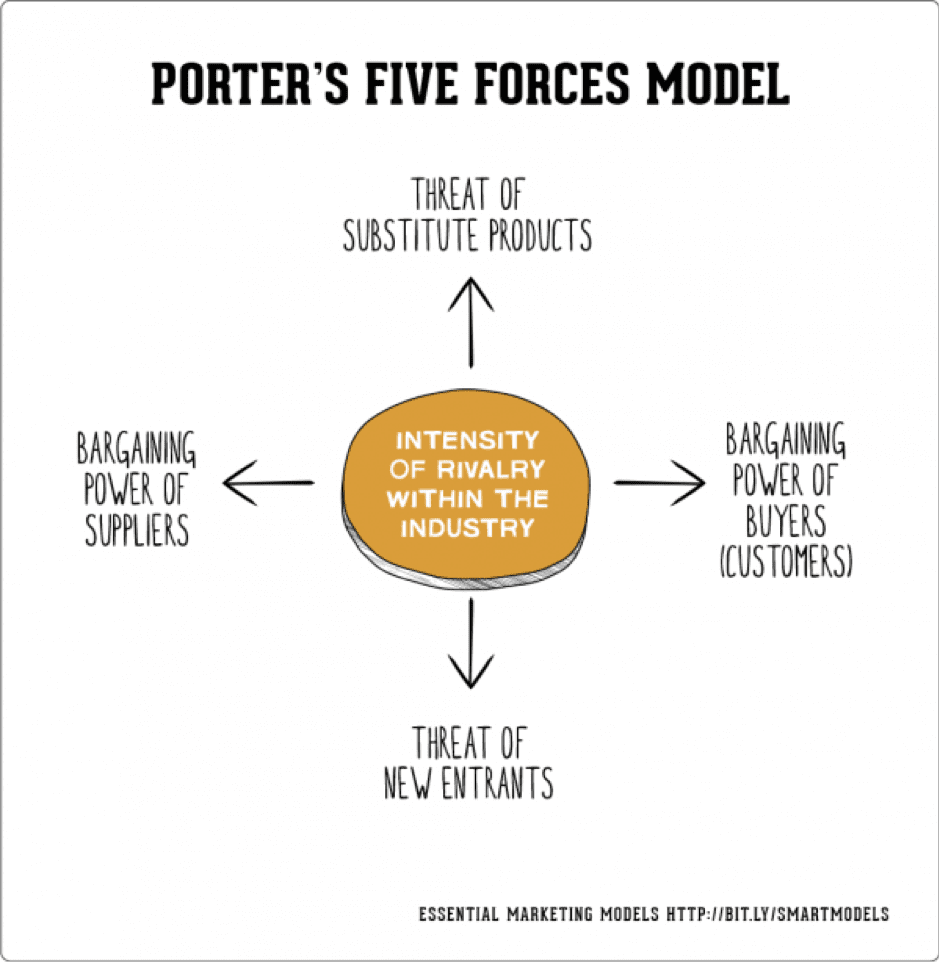Learn how to use Porter’s 5 Forces to assess your company’s marketplace viability and learn where the power lies between you and your customers
Porter’s 5 Forces is an analytical model that helps marketers and business managers look at the ‘balance of power’ in a market between different organizations on a global level, and to analyze the attractiveness and potential profitability of an industry sector.
What are Porter’s 5 Forces?
- Competitive rivalry
- Threat of substitute products
- Bargaining power of buyers
- Threat of new entrants
- Bargaining power of suppliers

How do Porter’s 5 Forces work?
Competitive rivalry
The first aspect to analyze is the amount of competition your company faces. Think both on a macro and micro scale about the number of direct competitors you have in your industry and the products/services they offer in comparison to yours.
Markets with few competitors are attractive but can be short-lived. On the other hand, highly-competitive markets with many companies chasing the same work reduce your power and can push you to lower your prices and innovate new products.
Consider:
- What’s the level of competition in your company’s sector?
- Who are your large, direct competitors? What advantages do they leverage over you?
- Who are your smaller, independent competitors? What do they do to stay competitive?
Threat of substitute products
This refers to the possibility that customers will find a different (read: quicker and easier) way of doing what your company does. You may have originally conceived products or services that help customers, but as technology changes over time, so do the desires and problems of customers.
Always examine how your customer’s lives have changed as your company has grown. For example, you may sell a piece of software that automates a process or synchronizes activity into one platform. As user behaviour changes, you can find opportunities to update your product, or even grow a new service offering.
Consider:
- How easy is it to find an alternative to your products or services?
- What aspects of your products/services can your customers do manually?
- How do cheaper substitutes measure up against your company for ROI?
Bargaining power of buyers
Ask yourself how much power do your buyers have over you. If you’re selling a product, their power is likely contained to order amounts or customization needs. However, if you’re offering a service, customers are more open to negotiation.
Remember that customers are extremely price-savvy and may already have experience of dealing with your competitors. Determining your relationship with buyer power is all about how flexible you can be on service while maintaining an authoritative position in your market.
Consider:
- How powerful are your buyers?
- How many are there? What different kinds of buyers do you interact with?
- Can the buyers get costs down?
- Do they have the power to dictate terms?
Threat of new entrants
Industries that are tightly regulated and require large investments of capital mean that companies who make it can gain a serious foothold in a market. Alternatively, markets that you can get set up in quickly and with little financial risk mean you can start building customers faster, though there may be a proliferation of copycat companies and similar products.
The threat of new entry is based on how secure your company is from being surrounded by competitors. Let’s say you’ve discovered a way to cut costs in the IT industry – you need to protect your company from imitators and rival companies who can drive down your prices.
Consider:
- What’s the threat of new businesses starting in this sector?
- How easy is it to start up in this business?
- What are the rules and regulations?
- What finance would a start-up need?
- Are there barriers to entry which give you greater power?
Bargaining power of suppliers
When it comes to brass tax, you need to focus as much on your costs as you do on your revenue. Assess the suppliers you rely on and the potential power they have over the products/services you provide.
The greater the number of suppliers available to you, the easier it is to switch to a cheaper alternative. If there are few suppliers you can work with, such as when you sell products made with highly-specific materials, the greater control they have over your company. A rise in their prices has an immediate effect on your bottom line.
Consider:
- How many suppliers are in the market?
- Are there many options (which can lower prices) or just a few (which can raise them)?
- How easy is it to switch, what’s the cost?
- How would changing suppliers affect your products/services?
How can you apply Porter’s 5 Forces?
If your business is thinking about moving into new sectors or markets, or if your business is stuck in a commodity situation, then Porter’s 5 Forces enables you to see the issues clearly.
Work through each of the forces to identify who has the power in different scenarios across each industry you work (or want to work) in.
Here are some examples of where the balance of power lies in different markets
Competitive rivalry
These include estate agents, web design, and office stationery. Many competitors often buy on price. There are many providers of very similar products, meaning that differences should be highlighted, and prices must be competitive.
Threat of substitute products
The substitute for all services is DIY. For example, anyone can cut their own hair or write their own will, but many people spend money to enlist the services of an experienced professional to deliver a level of service greater than they can provide themselves. Focus on expertise, customer service and added value your company can use to distinguish itself.
Bargaining power of buyers
An example is the grocery sector since supermarkets tend to retain power over suppliers due to volume and price of contracts. They dictate terms, set prices and can end agreements at any time.
Threat of new entrants
An example is web design, as there are independents in every location. This is an easy market to enter with few requirements, other than skills, initiative and relevant hardware and software. This does mean there are many new entrants!
Bargaining power of suppliers
Some sectors have monopolistic (one) or oligopolistic (few) suppliers, such as utility companies. Sometimes customers have little choice i.e. where to buy domestic water suppliers, though this is changing. In the jewellery sector, diamond suppliers often hold the power and can set prices, withhold supply and restrict sales.
What else should you consider?
This analytical model lets you assess the levels of control between your company and influential forces throughout the production journey, from suppliers to competitors and your consumers. Once you have worked through each section, you must make any changes you deem necessary to tip the balance of power towards your business.
Sometimes there may not be information readily available to you when considering one of the 5 Factors. At times, you may need to make assumptions, but only after you have tried other means of research. Try finding industry whitepapers or surveying a sample of your customers to discover insights you may not have when you begin your marketplace analysis.

